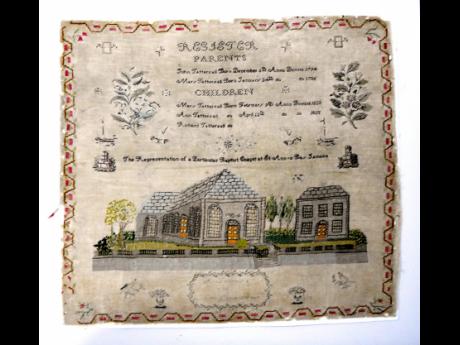History of samplers
Contrary to popular belief, embroidery is not an activity that is only employed by grandmothers to pass time by recreating pretty pictures.
From time immemorial, societies have found innovative ways to record and transfer their knowledge and history. One of the ways that societies have done this is through embroidery. Embroidery is the process of decorating fabric or other materials using a needle to apply thread or yarn while sometimes incorporating other materials such as pearls, beads, quills, and sequins into the design.
For example, embroidery has been used by the Miao culture in China for centuries to record their history, legends, and stories on their clothing because they have no written language. The tradition of embroidery can also be found in different cultures across the continent of Africa.
Different ethnic groups use various materials in their embroidery with the objective being to embody messages, histories, and identities in one's garments.
The tradition of embroidering ones' clothing is also found throughout Europe. In Europe, embroidery was used on clothing as status symbols by royals and aristocrats, who would literally have had their wealth embroidered on to their garments using gold thread along with the application of precious gems.
In Europe, embroidery was not only used on clothing, but on slim strips of fabric on which various types of stitches would be recorded as paper was not readily available. These small strips of fabric became known as samplers.
The Victoria and Albert Museum (England) explains that "in their earliest form, samplers were put together as personal reference works for embroiderers: trials of patterns and stitches which had been copied from others, records of particular effects achieved which could be recreated again. They would have been the work, not of children, but of more experienced embroiderers, and some, from their quality, of professionals".
The Fitzwilliam Museum (England) adds that as time passed, the purpose of sampler making changed to become the primary work of girls and women. As mentioned before, in the 17th century, samplers started out as narrow bands of fabric used for the record keeping of varied and complex stitching techniques. However in the 18th and 19th centuries, samplers were increasingly being used as an educational tool for girls from all social backgrounds.
FUNCTION
The function of the finished product, however, would be different. For an affluent girl, her sampler might now be displayed in the home to prove to family and friends her skill in needlework, good upbringing, and domesticity.
For a girl leaving a charity school, her example would prove to potential employers her ability to sew, mark, and mend personal and household linen. Furthermore, it was around this time that the shape of the sampler began to change from narrow to rectangular to accommodate moralising texts, pictorial motifs, and personal information. This change, however, was a gradual process, and some narrow-band samplers continued to be made in the early decades of the 18th century.
The introduction of samplers to the Caribbean region was done, presumably by those who colonised the area. The skill may have been passed on to the enslaved who worked as domestics by their masters. The sampler pictured was done by Ann Tattersall, who was 15 years old at the time. We know this because of the faded inscription at the bottom of the sampler.
The rest of the sampler reads as follows;
"Register Parents
John Tattersall Born December 6th Anno Domini 1784
Mary Tattersall Born January 24th do do 1786
CHILDREN
Mary Tattersall Born February 9th Anno Domini 1823
Anne Tattersall o April 12th do do 1825
Richard Tattersall do
The Representation of a Particular Baptist Church at St Ann's Bay Jamaica"
Note that the 'do' signifies the repetition of the same word from a previous line.
According to the Jamaica National Heritage Trust, "the St Ann Parish Church was completed in September 1871 and was consecrated by His Lordship the Bishop of Kingston, Rt Reverend Reginald Courtney, on Wednesday, September 20, 1871, as the Church of 'St. Anne'. The contract to erect the Parish Church was awarded to Climie, a Colonial Engineer.
"The main walls of this late Nineteenth Century Church are constructed of cut stone. Along each elevation of the building are a series of pointed arch windows. Between each window bay are buttresses. The apse of the Church is of a semi-octagonal shape with buttresses on the corner of each side, between which are pointed arch stained glass windows with the largest being at the east end of the building."
This sampler, though only recording a small part of a young girl's life, illustrates how many British customs were introduced into Jamaica. This sampler is also important because it was made outside of England in one of her colonies at a time when churches had fought for and won the abolition of slavery.
Did you know?
Many scholars believe that the term 'sampler' is derived from the Latin word exemplum, which means 'an example to be followed'. There is some conflict as to where and when the first sampler was made as one of the earliest existing samplers is thought to have been made in Ancient Peru, c. 200-500 AD, but Coptic pattern samplers have also been found in ancient Egyptian tombs, dating around AD 400-500. Other researchers have argued that the embroidery sampler came into existence in Spain during the 14th century.
Sources
A history of Samplers. Victoria and Albert Museum.
England's Royal School of Needlework. Hansen, T.K. (ed) & Madisoni, S.D. (ed). (2013). African Dress: Fashion, Agency, Performance. Bloomsbury Academic publishing.
Samplers. A History of English Embroidery.
St Ann Parish Church
Victorian Embroidery and Crafts. The Embroidery Sampler a brief History.
What is a sampler? The Fitzwilliam Museum.
- Information compiled by Sharifa Balfour, assistant curator, National Museum Jamaica

